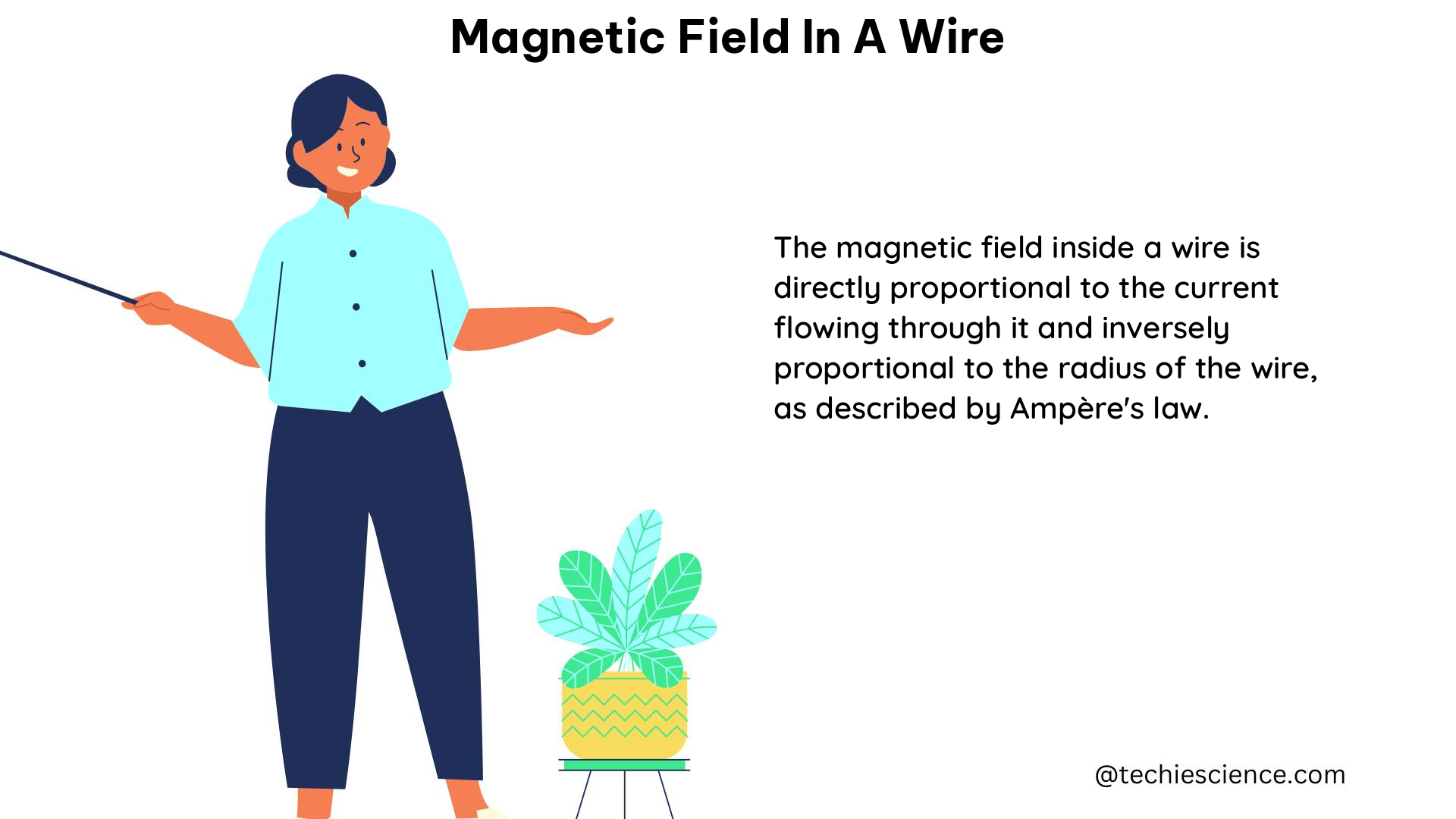The magnetic field in a wire is a fundamental concept in electromagnetism, where the movement of electric charges, such as electrons, within the wire generates a magnetic field that surrounds the wire. This magnetic field is proportional to the current and inversely proportional to the distance from the wire, as described by the Biot-Savart Law.
Understanding the Biot-Savart Law
The Biot-Savart Law is a fundamental equation that describes the magnetic field generated by a current-carrying wire. The magnetic field strength, B, at a distance, r, from a straight wire carrying a current, I, can be calculated using the formula:
B = (μ₀ * I) / (2 * π * r)
Where:
– B is the magnetic field strength in Tesla (T)
– μ₀ is the permeability of free space, which has a value of approximately 4π x 10^-7 T m/A
– I is the current flowing through the wire in Amperes (A)
– r is the distance from the wire in meters (m)
This equation demonstrates that the magnetic field strength is directly proportional to the current and inversely proportional to the distance from the wire.
Magnetic Field Direction and the Right-Hand Rule

The direction of the magnetic field around a current-carrying wire is determined by the right-hand rule. If the thumb of the right hand is pointed in the direction of the current flow, the fingers will curl in the direction of the magnetic field lines.

This rule is particularly useful when visualizing the magnetic field around a wire and understanding the relationship between the current and the resulting magnetic field.
Measuring Magnetic Fields in Wires
There are several methods used to measure the magnetic field in a wire, including:
-
Hall Effect: The Hall effect involves passing a current through a material and measuring the voltage generated perpendicular to the current and magnetic field. This voltage is proportional to the magnetic field strength.
-
Gaussmeter: A gaussmeter is a device specifically designed to measure magnetic fields, often using a Hall sensor. Gaussmeters can provide precise measurements of the magnetic field strength.
-
Magnetic Compass: A simple magnetic compass can be used to detect the presence of a magnetic field around a wire, although it may not provide quantitative measurements.
-
Smartphone Compass App: Some smartphone apps can use the built-in magnetometer to detect and measure the magnetic field around a wire, providing a convenient and accessible method for students.
Calculating the Force on a Current-Carrying Wire in a Magnetic Field
In addition to measuring the magnetic field, it is also possible to determine the magnetic field strength by measuring the force exerted on a current-carrying wire in a magnetic field. The force, F, on a wire of length, L, carrying a current, I, in a magnetic field, B, is given by the equation:
F = I * L * B * sin(θ)
Where:
– F is the force in Newtons (N)
– I is the current in Amperes (A)
– L is the length of the wire in meters (m)
– B is the magnetic field strength in Teslas (T)
– θ is the angle between the wire and the magnetic field in radians
By measuring the force and knowing the current and wire length, the magnetic field strength can be calculated.
Numerical Examples and Problems
- Example 1: Calculate the magnetic field strength at a distance of 5 cm from a wire carrying a current of 10 A.
Given:
– Current, I = 10 A
– Distance, r = 5 cm = 0.05 m
– Permeability of free space, μ₀ = 4π × 10^-7 T m/A
Applying the Biot-Savart Law:
B = (μ₀ * I) / (2 * π * r)
B = (4π × 10^-7 T m/A * 10 A) / (2 * π * 0.05 m)
B = 4 × 10^-5 T or 0.04 mT
- Example 2: A wire carrying a current of 5 A is placed in a magnetic field of 0.2 T. Calculate the force on a 10 cm section of the wire if the wire is perpendicular to the magnetic field.
Given:
– Current, I = 5 A
– Magnetic field, B = 0.2 T
– Wire length, L = 10 cm = 0.1 m
– Angle between wire and magnetic field, θ = 90° (perpendicular)
Applying the force equation:
F = I * L * B * sin(θ)
F = 5 A * 0.1 m * 0.2 T * sin(90°)
F = 0.1 N
These examples demonstrate the application of the Biot-Savart Law and the force equation to calculate the magnetic field strength and the force on a current-carrying wire in a magnetic field, respectively.
Additional Resources and References
- Magnetic Field due to a Current in a Straight Wire – Nagwa: https://www.nagwa.com/en/explainers/909137183476/
- Measuring Magnetic Fields: Two Unconventional Methods – Magnetic Compass and iPhone Compass App: https://www.wired.com/2014/01/measure-magnetic-field/
- Lab 5 – Force on a Wire – WebAssign: https://www.webassign.net/question_assets/ncsulcpem2/lab_5/manual.html
Hi…I am Keerthana Srikumar, currently pursuing Ph.D. in Physics and my area of specialization is nano-science. I completed my Bachelor’s and Master’s from Stella Maris College and Loyola College respectively. I have a keen interest in exploring my research skills and also have the ability to explain Physics topics in a simpler manner. Apart from academics I love to spend my time in music and reading books.
Let’s connect through LinkedIn